
New space study shows a surprisingly large number of massive stars across the universe
Thursday, August 16, 2018 by Edsel Cook
http://www.realsciencenews.com/2018-08-16-new-space-study-shows-there-is-a-surprisingly-large-number-of-massive-stars-across-the-universe.html

Most of the stars in the night sky are red dwarfs. But a new U.K. study has discovered that there is also an astonishingly larger number of much bigger stars in certain parts of the universe. An article in Space.com stated that the existence of this many massive stars could explain the changes that galaxies undergo during their lifetimes.
For the study, the researchers tapped the Atacama Large Millimeter/submillimeter Array (ALMA) in the Atacama Desert of northern Chile. The massive astronomical interferometer could observe the birth of stars in a quartet of starburst galaxies far, far away.
Those regions are overflowing with stellar gas that encourages the rapid formation of stars. Experts believe the stars in those four galaxies are created at least 100 times faster than in the Milky Way galaxy.
The massive stars in those galaxies regularly release huge amounts of stellar matter. They also erupt into supernovas that eject even more energy and gas into outer space. The European Southern Observatory (ESO) remarked that this high level of stellar activity would greatly affect the interstellar region around those energetic celestial bodies. (Related: Astronomers: Life has a “fighting chance” in planets around Alpha Centauri A and B.)
Massive stars are brighter than the Sun, but burn out faster
The researchers evaluated the starburst galaxies according to the way they distributed their stellar mass. A recently developed technique, akin to radiocarbon dating, picked out the distinct signatures of disparate isotopes of carbon monoxide.
Larger and more massive stars have plenty of oxygen isotopes. The carbon isotopes that the researchers were looking for were linked with smaller stars of medium mass.
University of Edinburgh researcher Zhi-Yu Zhang stated that the combination of carbon and oxygen resulted in carbon dioxide. The larger the star, the more often it forms different kinds of carbon monoxide. This validated pattern made it easier for researchers to identify the mass of a star.
Stars with low mass have very long lifespans. The Sun, for example, is a middle-aged star that will continue to shine long after humans are gone.
Massive stars, on the other hand, have much shorter lifespans. Researcher Zhang stated that the distribution of various types of stars can reveal the age and state of a galaxy during a particular period of time. A larger number of massive stars would indicate a relatively young galaxy.
The universe and local galaxies have many more massive stars than predicted
Zhang and his colleagues reported that the starburst galaxies contained far more massive stars than earlier believed. They further stated that these results were similar to those of another study that covered the Tarantula Nebula of the Large Magellanic Cloud.
The Large Magellanic Cloud is a satellite galaxy of the Milky Way. It is one of the closest galaxies, being a mere 163,000 light-years away from the Milky Way.
Its Tarantula Nebula is rich with giant stars. Also called 30 Doradus, this interstellar cloud of space dust and gas is considered to be the brightest star-forming region in the Local Group that includes the Milky Way.
A different research team, this one from the University of Oxford, reported spotting incredibly huge stars that weighed anywhere from 30 to 300 times the weight of the Sun. There were also far more of these massive stars than expected.
“Our findings lead us to question our understanding of cosmic history,” said Rob Ivison, the ESO’s director for science and co-author of the new study. “Astronomers building models of the universe must now go back to the drawing board, with yet more sophistication required.”
There are lots more articles about the stars at Cosmic.news.
Sources include:
Tagged Under: Tags: carbon monoxide, cosmic, cosmos, discoveries, Galaxies, galaxy, goodscience, massive stars, Milky Way, research, Space, starburst galaxies, Stars, Universe





